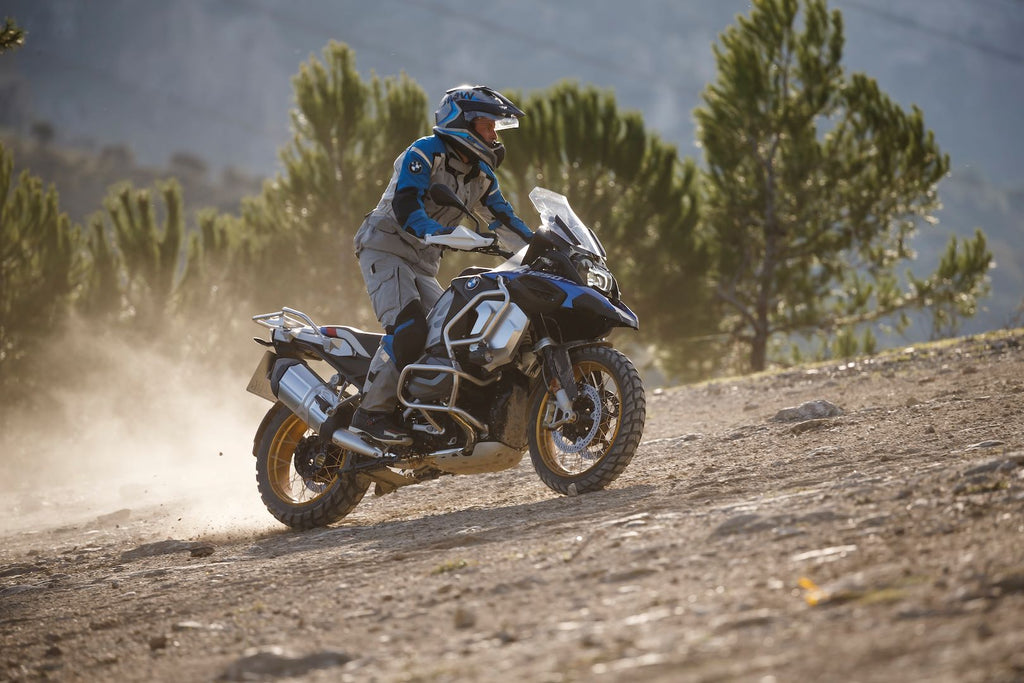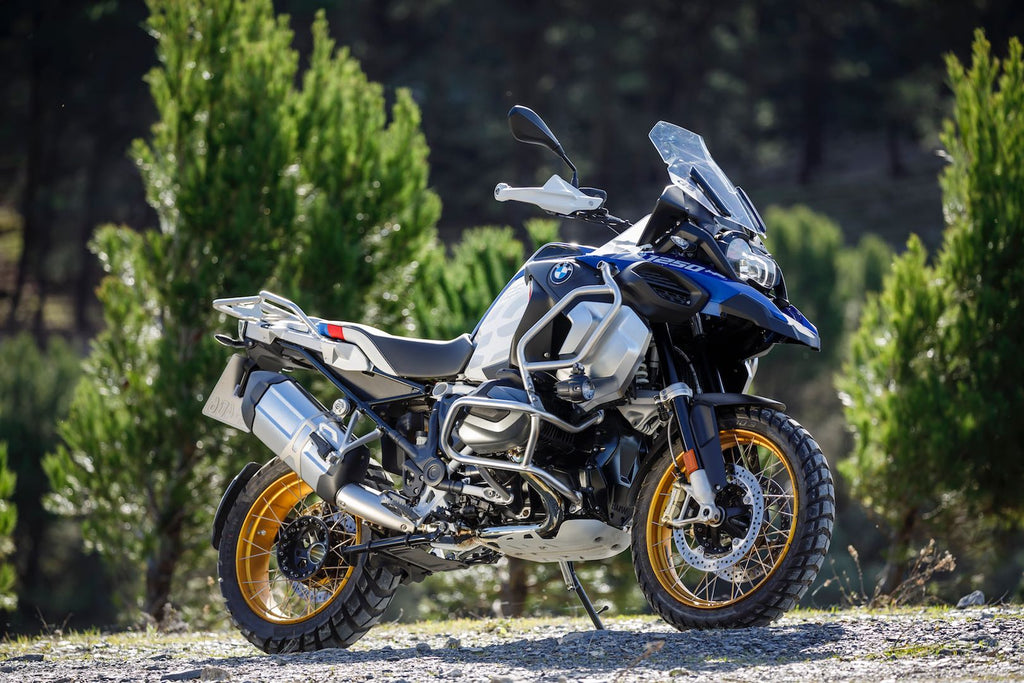BMW R 1250 GS vs. R 1200 GS: Was hat sich zum Besseren verändert?

ADV-Fahrer aufgepasst: Es gibt ein neues Motorrad in der Stadt - die BMW R 1250 GS und die BMW R 1250 GS Adventure.
OK, wir haben es kapiert: Die alte R 1200 GS hatte ernsthaftes Potenzial und konnte so ziemlich alles bewältigen, was ihr in den Weg gestellt wurde. Sie können also ohne Bedenken mit Ihrer alten Begleiterin weiterfahren.
Aber BMW Motorrad strebt nach der absoluten Perfektion des Abenteuertourismus. Mit dieser Idee im Hinterkopf hat BMW das Modelljahr 2019 mit allem ausgestattet, was nötig ist, um die Grenzen des Abenteuers zu verschieben, und nichts, was es nicht gibt. Sie hat mehr Power, modernste Fahrerassistenzsysteme und verbesserte Komfortfunktionen, die Ihre Fahrt noch angenehmer machen.
Großartig wurde gerade noch größer.

2020 BMW R 1250 GS in Aktion
Im Folgenden gehen wir auf die Upgrades der R 1250 GS und R 1250 GS Adventure ein und stellen die wichtigsten Neuerungen gegenüber dem Vorgängermodell vor. Dies ist die oberste Stufe der ADV-Touring-Baureihe.
Bisherige GS-Besitzer aufgepasst: Ein paar Kilometer auf der aktualisierten R 1250 GS oder GS A können und werden Sie dazu bringen, Ihr altes Gefährt gegen das neueste und beste einzutauschen. Hust... wir haben genau das getan.
BMW erhöht den Hubraum bei der 2019er GS und setzt die BMW ShiftCam Technologie ein
Die größte Neuheit der BMW R 1250 GS und GS Adventure? Der vergrößerte Hubraum des Boxermotors und der Einsatz der BMW ShiftCam Technologie.
Der zusätzliche Hubraum ist ein direktes Ergebnis der Überarbeitung der grundlegenden Architektur der Zylinder des Motors durch BMW. Motorrad hat die Bohrung und den Hub des neuen Layouts auf 102,5 x 76,0 mm vergrößert, im Gegensatz zu den 101,0 x 73,0 mm der R 1200 GS aus dem Jahr 2004.
Der Gesamthubraum steigt um 84 cm³ auf 1254 cm³, sogar mehr als die Umbenennung von R 1200 in R 1250 vermuten lässt.
- BMW überarbeitet die Motorarchitektur und vergrößert sowohl die Bohrung als auch den Hub, um 84 cm³ zusätzlich zu gewinnen
- 5 X 76,0 mm Bohrung und Hubmessung
- Größerer 1254ccm-Hubraum
Und was hat es mit der ShiftCam-Technologie auf sich? Es handelt sich dabei um das variable Ventilsteuerungssystem von BMW Motorrad mit zwei Nockensätzen für die Einlassnockenwelle - Partial Load und Full Load -, die beide je nach Motordrehzahl und Last genutzt werden.
Aber warum ein System mit variabler Ventilsteuerung bei einem ADV-Motorrad mit großem Hubraum? Das ist ganz einfach: Diese Art von Motorrädern braucht das Beste aus allen Welten. Die Spitzenleistung, die erforderlich ist, um ein fast 600 Pfund schweres Motorrad bei Autobahngeschwindigkeiten anzutreiben, erfordert ein späteres Schließen der Einlassventile und eine größere Ventilüberschneidung bei hoher Belastung.
Andererseits müssen die Einlassventile nahe der oberen Mitte öffnen und nahe der unteren Mitte schließen, um ein kontrollierbares Ansprechverhalten und ein Drehmoment im mittleren Drehzahlbereich zu erreichen, das den unterschiedlichen Oberflächen, die ein ADV-Motorrad befahren wird, gerecht wird.
- BMW ShiftCam nutzt zwei Einlassnocken, um die Leistung zu erhöhen und zu verbreitern
Schweben wie ein Schmetterling, stechen wie eine Biene!

BMW R 1200 GS - immer noch erstaunlich, aber nicht so gut wie die R 1250 GS
Mehr POWER - Das Ergebnis von Motorverbesserungen
Ein größerer Hubraum und der Einsatz der BMW ShiftCam Technologie bedeuten für die 2019er R 1250 GS eine gesteigerte und optimierte Leistungsentfaltung.
BMW Motorrad gibt an, dass die neue GS 136 PS bei 7750 U/min leistet und ein maximales Drehmoment von 105 Pfund bei 6250 U/min erreicht. Zum Vergleich: Das sind 11 PS und 13 Pfund mehr Drehmoment als bei der bisherigen R 1200.
Entscheidend ist jedoch, wo die Leistung erzeugt wird. Vereinfacht ausgedrückt, ist die R 1250 im gesamten Drehzahlbereich etwa fünf bis zehn Prozent stärker als die R 1200.
Beispiel? Von 6.250 bis 9.000 U/min leistet der 1250er Motor mehr PS als der 1200er in der Spitze. Ebenso produziert der 1250er zwischen 4.000 und 7.500 Umdrehungen pro Minute ein Drehmoment von mindestens 92 Pfund, während der 1200er dies erst bei 6.500 Umdrehungen pro Minute erreicht.
Zusätzliches Plus: Der geschätzte Kraftstoffverbrauch der BMW R 1250 GS verbessert sich um sechs Prozent.
- Gesteigerte und optimierte Leistungs- und Drehmomentwerte im Vergleich zur R1200
- Behauptete 136 PS bei 7750 U/min
- Angeblich 105 Pound-feet @ 6250 rpm
- Verbesserter Kraftstoffverbrauch
Der neue Motor glänzt an der Spitze und zieht bis zu 9.000 Umdrehungen pro Minute, was bedeutet, dass er auf offener Straße viel Kraft zum Überholen hat und schnell von einer Kurve zur nächsten rennt.
Im unteren Drehzahlbereich beweist die ShiftCam jedoch ihren Wert. Beim Navigieren durch felsiges, technisches Terrain ist die Leistungsentfaltung der R 1250 GS außergewöhnlich sanft und kontrollierbar. Betrachten Sie die GS als Traktor bei langsamen Geschwindigkeiten, mit der Fähigkeit, spontane Wheelies im dritten Gang auf der Autobahn zu machen.
2019: Das Jahr der elektronischen Suite
Was für eine Zeit, um ADV-Fahrer zu sein! BMW Motorrad hat die BMW R 1250 GS mit einer ganzen Reihe von elektronischen Fahrhilfen ausgestattet - viele davon stammen aus dem Bereich der offenen Sportmotorräder -, die die Sicherheit, den Komfort und die Effizienz auf der Langstrecke verbessern sollen, ohne dabei den emotionalen Charakter der legendären ADV-Plattform zu beeinträchtigen.
Die voll ausgestattete BMW R 1250 GS lässt sich nahezu unbegrenzt an die Vorlieben des Fahrers anpassen. Das zusätzliche Premium-Paket im Wert von 3.500 USD öffnet die Türen zur vollständigen Einstellbarkeit der Pro Riding Modes des Motorrads, der Gasannahme-Einstellungen, einschließlich der Dynamic Traction Control-Stufen, der ABS Pro-Einstellungen und der Dynamic Brake Control (ein Whiskey-Drosselklappen-Sicherheitsnetz!).
Das Premium-Paket ist außerdem mit einer semi-aktiven elektronischen Fahrwerksanpassung der nächsten Generation und dem Schaltassistenten Pro (bidirektionale Schnellschaltung) ausgestattet, sowie mit beheizbaren Griffen, Tempomat, Reifendruckkontrolle, schlüssellosem Fahren und vielem mehr.
- Einstellbare Pro Riding Modes
- Dynamische Traktionskontrolle
- ABS Pro
- Dynamische Bremsensteuerung
- Tempomat
- Beheizte Griffe
- Tire Pressure Monitor
Natürlich wird jede der einstellbaren Fahrhilfen über ein sehr großes und leicht ablesbares 6,5-Zoll-TFT-Farb-Dashboard eingestellt, das einen großen Drehzahlmesser, eine Ganganzeige und vieles mehr enthält.

Die R 1250 GS ist eine reine ADV-Schönheit
Der bisher größte und schlimmste GS
Mit der 2019er R 1250 GS hat BMW die bisher leistungsstärkste und technologisch fortschrittlichste ADV-Touring-Plattform geschaffen.
Die GS mit dem größeren Hubraum erfährt signifikante Verbesserungen an ihrem Triebwerk, einschließlich der BMW ShiftCam Technologie, die die Leistungsabgabe über den gesamten Drehzahlbereich optimiert und verbessert.
Die 1250 erhält außerdem eine Liste zusätzlicher Fahrhilfen, die dabei helfen, die nächste Strecke zu bewältigen und sich dabei noch ein wenig wohler zu fühlen.
Glauben Sie uns, wenn wir sagen, dass die geliebte GS ihren Charakter nicht verloren hat, sondern nur Verbesserungen erhalten hat, die sie für die nächsten Jahre an der Spitze des ADV-Marktes halten werden.
2019 BMW R 1250 GS Technische Daten
Motor
- Verdrängung: 1254ccm
- Typ: luft-/flüssigkeitsgekühlter DOHC-Boxer mit BMW ShiftCam Technologie.
- Bohrung x Hub: 102,5 x 76,0 mm
- Verdichtungsverhältnis: 12,5:1
- Getriebe: 6-Gang
- Endantrieb: Kardanantrieb
- Betankung: Elektronische Kraftstoffeinspritzung mit Ride-by-Wire
- Angegebene Leistung: 136 Pferdestärken bei 7750 U/min
- Behauptetes Drehmoment: 105 pound-feet @ 6250 rpm
Fahrgestell/Kapazitäten
- Rahmen: Durchgehendes Stahlrohr in Brückenform
- Vorderradaufhängung: BMW Telelever 37mm Gabel mit Zentralfederbein; 8,3 Zoll Federweg
- Hinterradaufhängung: BMW EVO Paralever und WAD-Federbein mit einstellbarer Federvorspannung und Zugstufendämpfung; 8,7 Zoll
- Vorderrad: 3.00 x 19; Drahtspeiche quer
- Hinterrad: 4,50 x 17; Drahtspeiche quer
- Vorderreifen: 120/70 x 19
- Hinterreifen: 170/60 x 17
- Vordere Bremsen: Zwei schwimmend gelagerte 305-mm-Scheiben mit 4-Kolben-Festsätteln
- Hinterradbremse: 276-mm-Scheibe mit Zweikolben-Schwimmsattel
- Leergewicht: 591 lb.
- Kraftstoffkapazität: 7,9 lb.